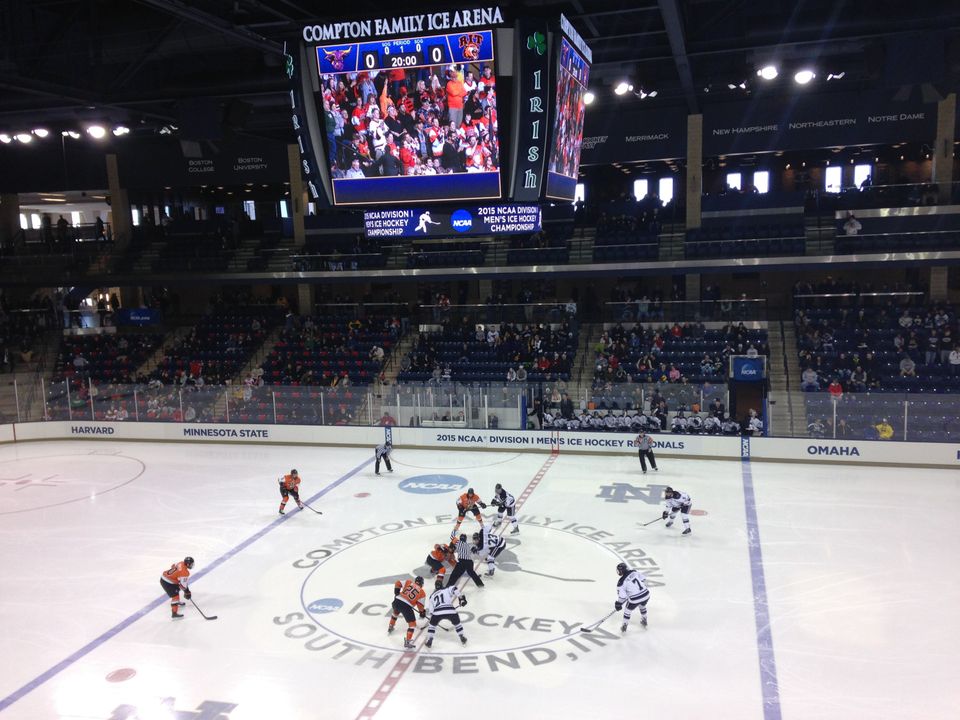April 3, 2015
By J.P. Bruno ’18
Just over a year ago, the staff at Compton Family Ice Arena came up with the idea to submit a bid to host the NCAA Hockey Regional March 28 and 29. Tom Nevala, general manager of Compton, was shocked to learn that Notre Dame had received the bid.
“Frankly, going into it we didn’t think we’d get the opportunity to host,” Nevala says, “Generally the ice hockey committee does not select on-campus sites, and more `neutral’ locations are favored.”
Nevertheless, the staff was honored by their selection and vowed to do everything possible to be a welcoming home for the travelling teams.
“In August the NCAA came to campus and did a walkthrough of the building,” says Mike Sheggeby, operations director at Compton. “Since then we had monthly, sometimes weekly, conference calls with the NCAA making sure we were very clear on their expectations.”
And the NCAA has very particular expectations when it comes to host sites for the hockey regionals. Mike McNeill, programming director at Compton, helped organize the many different groups of people involved.
“Staffing a regional means several different groups all working together,” McNeill says. “Ushers, police, firemen, trainers, doctors, media relations, tickets, marketing, rink operations, etc. “
Early on it’s all about developing a marketing and ticketing strategy. Of course, this all depends on what teams actually make the tournament. Two plans were then crafted: one based on if Notre Dame made the tournament and the other if not. Both plans included working within the South Bend community.
“We worked with Visit South Bend to make sure the community was welcoming to those coming from out of town,” Nevala says. “Airports, hotels, restaurants – all were aware that there was an influx of guests. Even more, we tried to make the South Bend community aware that such a major event was going on here.”
Once the teams were established, physical changes to the facility began to take shape.
“Getting Compton ready was lots of work,” McNeill says. “Logos needed to go in the ice, the boards needed to be cleaned and ready for NCAA requirements, glass needed to be cleaned, locker room areas needed to be set up for the four visiting teams and the Notre Dame hockey team room and dining room were turned into press conference room and media room.”
Over the few weeks leading up to the games, banners were arriving on a daily basis to the loading dock for Mike Sheggeby’s staff to hang around the arena. On the Sunday before teams arrived, Sheggeby’s staff began work on resurfacing and redecorating the ice.
“We shaved down the ice to about one-half an inch and whited out the logos that were previously on the ice to replace them with the logos that are required for the NCAA tournament, ” Sheggeby says. “We even repainted the lines just to brighten everything up. Clearly the staff did a good job – even the referees commented on the quality of the ice surface.”
As a finishing touch, in each team’s section of the arena the staff placed T-shirts that were the team colors.
For hockey fans near and far, the NCAA regionals are a way to see facilities across the country. This was Notre Dame’s first time ever hosting a hockey regional, and the publicity that comes along with it is a great bonus.
“Many of these fans don’t typically come around here, so we get the opportunity to show them our facility” Sheggeby says. “Even just the television exposure is huge. It’s a chance for us to show off what we can do with this great facility that we have.”
“Fans spent some time touring campus,” McNeill says. “Even the RIT hockey team took a tour. It’s a showcase: of us, our facility, our campus and our city.”
The NCAA Hockey Regionals are also a source of high-level competition. The first round is only a field of 16, and the winners of the regional weekends advance to the Frozen Four.
“You’re going to see some great competition regardless of who is playing,” Nevala says.
And for the teams that get the opportunity to play in the regional, Notre Dame became their new home – and the staff did its very best to make it feel that way.
“We had over 60 ushers and 20 student media relations workers per game, in addition to designated team assistants,” Sheggeby says. “We received nothing but positive feedback about the environment.”
To create such a welcoming atmosphere in such an efficient way, Nevala believes the two most important elements were teamwork and communication.
“In order to pull off such a feat, everyone needed to be on the same page from day one,” Nevala says. “It’s a lot of hard work, by a lot of people.”
The staff at Compton Family Ice Arena knew that what they were applying for was a huge time commitment, but they wanted to prove they were up for the challenge. The staff has set a high bar for hosting a hockey regional on campus, and the example set by Notre Dame is sure to be used by collegiate hosts nationwide for years to come.
For the staff, there was only one difficulty.
“The hardest part of hosting the regional was that Notre Dame was not playing in it,” Nevala says. “All along that was a goal – that we would get a home-ice advantage.”
“We were all proud of Omaha for earning the opportunity to advance to the Frozen Four,” McNeill says. “But it was one of the most difficult things to watch: another team celebrating on our ice in our arena.”
Notre Dame wasn’t the only team heartbroken, but all recognize that as just part of the sport.
“Only one team really leaves happy about the results,” Nevala says. “We just needed to make sure that everyone felt welcome in the time they spent here.”







